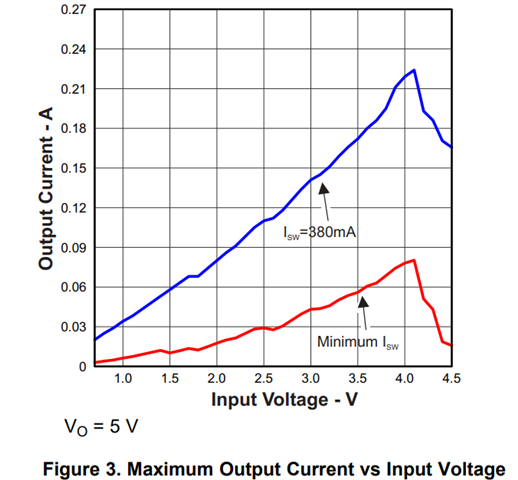Other Parts Discussed in Thread: TPS61220
Hello.
With the TLV61220, is it possible to boost the output voltage to 5.0V when the input voltage is 0.7V?
Thank You.
This thread has been locked.
If you have a related question, please click the "Ask a related question" button in the top right corner. The newly created question will be automatically linked to this question.
Thank you for your answer.
I would like to ask you an additional question.
Question ①:
Currently, I think that the current consumption of the output load is about 40mA.
Is it possible to use even in the above case even when the input voltage is 0.7V and the output voltage is 5.0V?
Question (2):
Which graph in the data sheet can be used to understand the relationship between the input voltage and output voltage of the TLV61220?
Question ③:
Another device has TPS61220, is this the same characteristic as the TLV61220 device?
If so, since the data sheet of TPS61220 had a relational graph of input voltage, output voltage, etc., can it be used as a reference for the characteristics of TLV61220 by looking at the data sheet of TPS61220?
Thank you.
Hi Sir,
Please see my comments below:
Question ①:
Currently, I think that the current consumption of the output load is about 40mA.
Is it possible to use even in the above case even when the input voltage is 0.7V and the output voltage is 5.0V?
[WW]It has high risk using TLV61220 in this high current. See below maximum output current vs different Vin. As you can see, when Vin is below 1.0V, output current capability is limited.

Question (2):
Which graph in the data sheet can be used to understand the relationship between the input voltage and output voltage of the TLV61220?
[WW]See above Figure 3. You can also refer to datasheet Figure 1-2.
Question ③:
Another device has TPS61220, is this the same characteristic as the TLV61220 device?
If so, since the data sheet of TPS61220 had a relational graph of input voltage, output voltage, etc., can it be used as a reference for the characteristics of TLV61220 by looking at the data sheet of TPS61220?
[WW]It is still risky using TPS61220 from 0.7V to 5V.
I would recommend you maybe looking at TPS61099X, it has good efficiency from light load to heavier load, and still holds low solution size.
In addition, could you please share more application information about it? Why input can be as low as 0.7V and why load as 40mA?
-Wenhao
Thank you for your answer.
The reason I asked if the input voltage can be driven at 0.7V is because I intend to use an electric double layer capacitor (2.5V/4.7F) on the input side. I wanted to know if the output voltage can be maintained at 5.0V even if the input voltage drops by 0.7V as the electric double layer capacitor is discharged. I am currently considering a design that will allow the input voltage to be around 1.0V.
Also, the load is a relay. The load is a relay, so I think I need about 40mA to drive the output.
Thank you very much for your help.